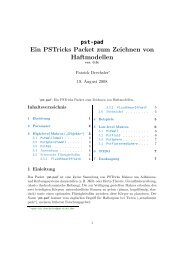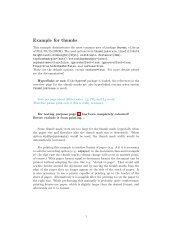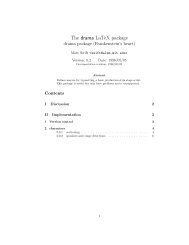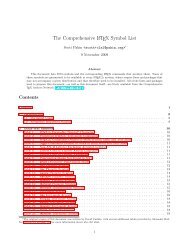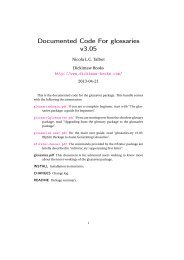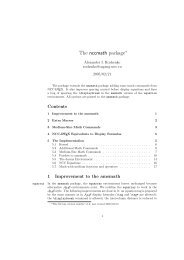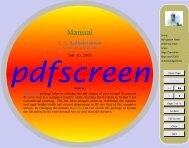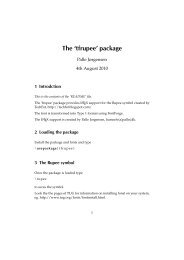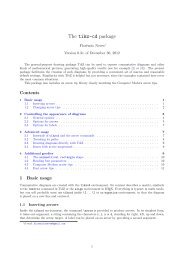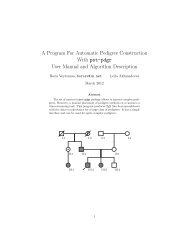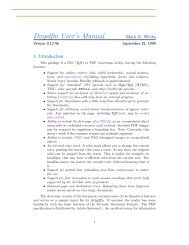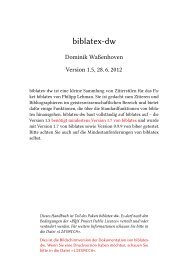ntheorem.pdf. - Mirrors.med.harvard.edu
ntheorem.pdf. - Mirrors.med.harvard.edu
ntheorem.pdf. - Mirrors.med.harvard.edu
Create successful ePaper yourself
Turn your PDF publications into a flip-book with our unique Google optimized e-Paper software.
5 The End Mark Algorithm<br />
5.1 The Idea<br />
The handling of endmarks with thmmarks.sty is based on the same twopass<br />
principle as the handling of labels: the necessary information about<br />
endmarks is contained in the .aux file.<br />
With thmmarks.sty, TEX is always aware whether it is in some theorem-like<br />
environment. There, potential positions for endmarks can be<br />
1. at the end of simple text lines in open text,<br />
2. at the end of displaymaths,<br />
3. at the end of equations or equationarrays, or<br />
4. at theendof text lines at theendof lists (or, moregeneral, trivlists,<br />
such as verbatim or center).<br />
The problem is, that in the cases (2)–(4), the endmarks has to be placed in<br />
a box which is already shipped out, when \end{...} is processed. Thus, in<br />
those situations, TEX needs to know from the .aux file, whether is has to<br />
put an endmark.<br />
When TEX is in a theorem-like environment and comes to one of the points<br />
mentioned in (2)–(4), and the .aux file says that there is an endmark, then<br />
it is put there. Anyway, it maintains a counter of the potential positions of<br />
an end mark in the current theorem-like environment. When it comes to an<br />
\end{theorem}, it looks if it is in situation (1) (then the endmark is simply<br />
put at the end of the current line). Otherwise, the last horizontal box is<br />
already shipped out (thus it contains a situation (2)–(4)) and the endmark<br />
must be set in it. In this case, a note is written in the .aux file, where the<br />
endmark actually has to be set (ie, at the latest potential point for setting<br />
an endmark inside the theorem).<br />
5.2 The Realization<br />
Let 〈env〉 be a theorem-like environment. Then, additional to the counter<br />
〈env〉, TEX maintains two counters curr〈env〉ctr and end〈env〉ctr. In<br />
the ith environment of type 〈env〉, curr〈env〉ctr= i (the L ATEX counter<br />
〈env〉 cannot be used since a) environments can use the counter of other<br />
environments, and b) often counters are reinitialized inside a document).<br />
end〈env〉ctr counts the potential situations for putting an endmark inside<br />
an environment. It is set to 1 when starting an environment. Each time,<br />
when a situation (2)–(4) is reached, the command<br />
\mark〈env〉<br />
28



